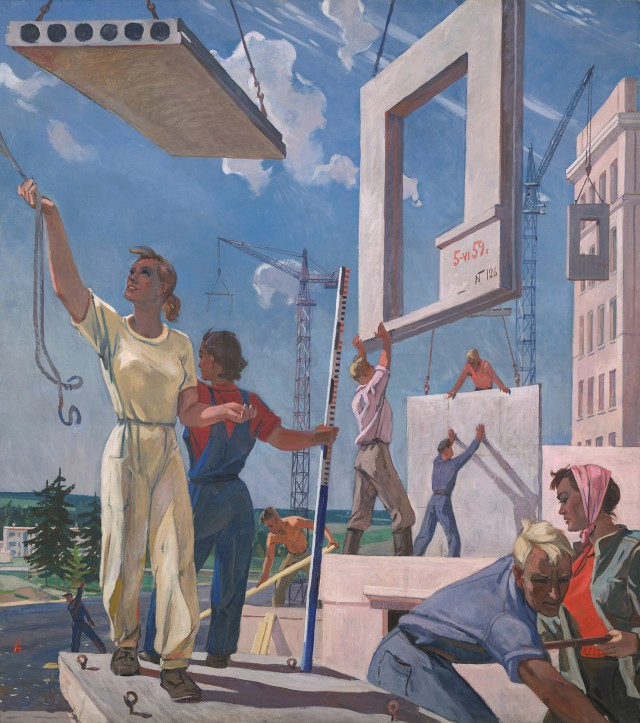Flying Panels
Housing billions of people, apartment blocks made of prefabricated concrete panels are one of the most common buildings in the world. Flying Panels – How Concrete Panels Changed the World tells of the time when a concrete panel soaring across the sky symbolised the future and embodied dreams of a better world. The exhibition also tells of the concrete panel systems in contemporary architecture.
Flying Panels gives an account of the evolution of the concrete panel, a building component often derided as the ugly face of our cities. But in the optimistic post-war period, the panel would build the future, cure the housing shortage and raise living standards for millions of people. The prefabricated concrete panels were at the heart of construction systems that spread to over 70 countries following the Second World War. The systems were further developed and adapted to local needs and circumstances in the different countries, with the new technique providing almost endless scope for variation.
Images of flying concrete panels were frequent in the 1950s and ‘60s. The exhibition illustrates the cultural impact and dissemination of the panels through examples of poster art, paintings, films, toys, cartoons and opera sets. A focal point of the exhibition is a suspended 1:5-scale model of one of the most representative concrete panel systems. Other key features are models of 60 modular systems from six continents.
Flying Panels is the result of years of research by curators Pedro Ignacio Alonso and Hugo Palmarola, who have gathered original material and catalogued and produced 3D models of concrete panel systems used across the world. The exhibition also outlines the history of concrete panels in Sweden, from the Million Programme and standardisation to the television series Hammarkullen.
Curators: Pedro Ignacio Alonso and Hugo Palmarola
Curator ArkDes: Carlos Mínguez Carrasco
Exhibition producer: Sofia Liljergren
Exhibition design: Note Design Studio
Graphic design: Brand Union
Lightning and Audiovisual technic: Transpond
Content developer: José Hernández
Multimedia development: Francisco Hernández
Content development team: Joaquín Broquedis, Tatiana Carbonell, Yazmín Jiménez, Daniela Manzur, Tamaya Sapey-Triomphe
Research Sweden: Erik Stenberg, Erik Sigge
Research USA: Michael Abrahamson
Director ArkDes: Kieran Long
Project team ArkDes: Madeléne Beckman, Lena Biörnstad Wranne, Markus Eberle, Daniel Golling, Tina Helmersson Landgren, Lena Landerberg, Frida Melin, Stefan Mossfeldt, Sandra Nolgren, Eva-Lisa Saksi, Elisabet Schön, Halla Sigurðardottir, Maria Östman
This exhibition is made possible with the support of:
KTH Royal Institute of Technology, School of Architecture; Pontifica Universidad Católica de Chile (PUC), International Artists Studio Program (Iaspis), Direction of Cultural Affairs (Dirac) at the Ministry of Foreign Affairs of Chile, and the Embassy of Chile in Sweden
ArkDes wants to thank the different individuals and institutions that have collaborated in the project by lending their material and artworks for the exhibition:
Canadian Centre for Architecture; Chicago Opera Theatre; Department of Architecture and Urban Planning, Ghent University; Erik Stenberg personal collection; Forbach City Council; Emily Harvey Foundation; Moderna Museet; Museum of the Chilean Toy; Mosfilm; Philipp Meuser personal collection, Rockefeller Foundation Bellagio Center; Sergio Larraín García-Moreno Archive at the Faculty of Architecture, Design and Urban Studies, Pontificia Universidad Católica de Chile; Skarne family Collection; Soyuzmultfilm; Stockholms Stadsarkiv; St. Petersburg State Museum of Theatre and Music; Tretiakov Gallery; Stockholm University Library
With special thanks to:
Michael Abrahamson, Petr Antonov, Felipe Aravena, Hernán Bascuñán, Luis Eduardo Bresciani, Juan Candia, Yongquan Chen, Rika Devos, Ivar Duvhök, Alexander Gronsky, Boris Groys, Philipp Meuser, Germán Perotti, Nolberto Salinas González, Ignacio Sánchez, Rodrigo Ramírez, Juan Antonio Santis, Thérèse Schluter, Filip Skarne, Natalya Solopova, Erik Stenberg, Martín Tironi, Alice Thiberg, Mario Ubilla, Sonja Vidén, and Angélica Zegers
